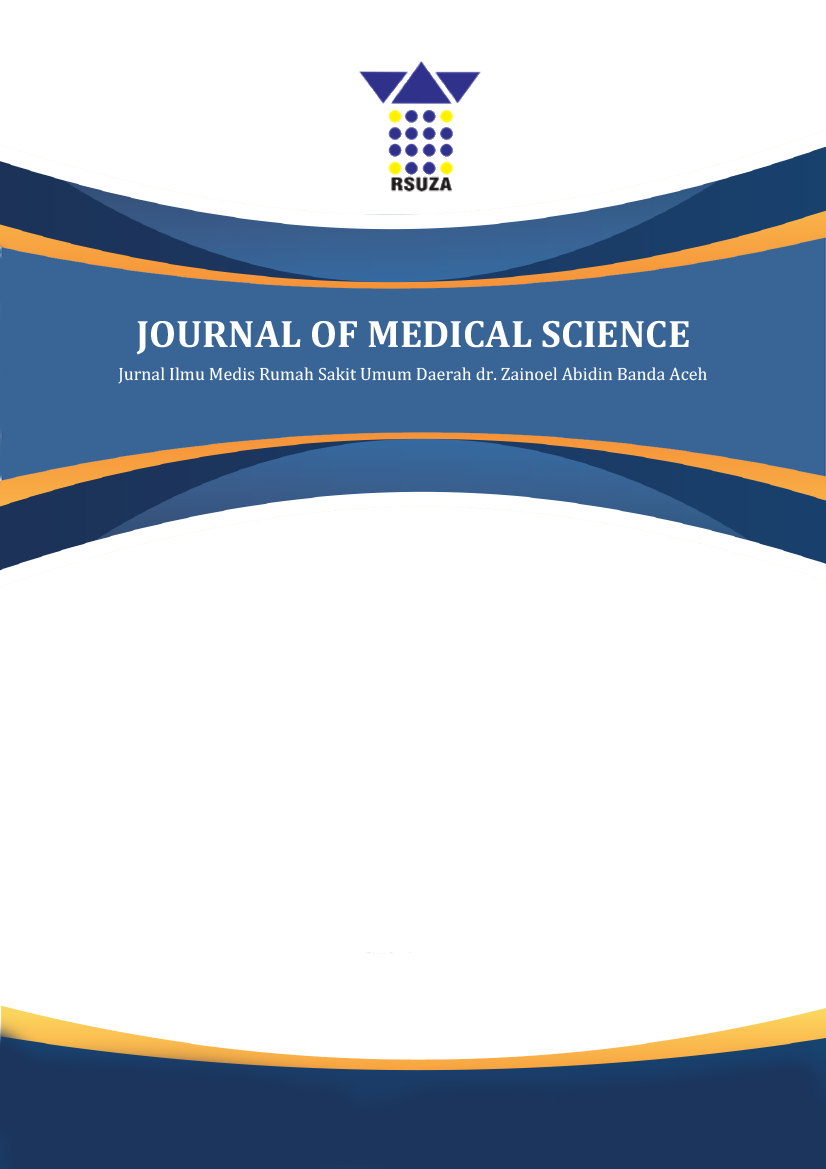Abstract
Sebagian besar pasien stroke mengalami kecacatan pasca-stroke, sehingga diperlukan intervensi untuk meminimalkan kecacatan dan memperbaiki keluaran klinis. Salah satu pendekatan yang dapat digunakan adalah stimulasi saraf, seperti stimulasi I point, yang diharapkan mampu meningkatkan fungsi saraf dan mengurangi defisit neurologis. Penelitian eksperimental sederhana ini melibatkan 40 pasien stroke iskemik akut yang dirawat di ruang saraf RSUDZA Banda Aceh, terdiri atas 20 subjek kelompok perlakuan dan 20 subjek kelompok kontrol. Kelompok perlakuan menerima terapi standar (antiagregasi) dan stimulasi I point, sedangkan kelompok kontrol hanya terapi standar. Keluaran stroke dinilai menggunakan Indeks Barthel (IB) dan Modified Rankin Scale (mRS). Data dianalisis menggunakan uji t berpasangan, dengan karakteristik dasar subjek homogen (p>0,05). Rerata skor IB-2 pada kelompok perlakuan (16,8 ± 3,7) secara bermakna lebih tinggi dibanding kelompok kontrol (14,9 ± 4,7; IK95%, p=0,046). Selisih skor IB-1 dan IB-2 juga lebih besar pada kelompok perlakuan (6,6 ± 4,1) dibanding kontrol (4,4 ± 2,5; IK95%, p=0,048). Stimulasi I point secara bermakna meningkatkan skor Indeks Barthel dan memperbaiki keluaran klinis pasien dengan stroke iskemik akut.
References
Alia, C. et al. (2017) ‘Neuroplastic changes following brain ischemia and their contribution to stroke recovery: Novel approaches in neurorehabilitation’, Frontiers in Cellular Neuroscience, 11(March), pp. 1–22. Available at: https://doi.org/10.3389/fncel.2017.00076.
Billinger, S.A. et al. (2014) ‘Physical activity and exercise recommendations for stroke survivors: A statement for healthcare professionals from the American Heart Association/American Stroke Association’, Stroke, 45(8), pp. 2532–2553. Available at: https://doi.org/10.1161/STR.0000000000000022.
Chaiyawat, P., Kulkantrakorn, K. and Sritipsukho, P. (2009) ‘Effectiveness of home rehabilitation for ischemic stroke’, Neurology International, 1(1). Available at: https://doi.org/10.4081/ni.2009.e10.
Duncan, P.W., Jorgensen, H.S. and Wade, D.T. (2000) ‘Outcome measures in acute stroke trials: A systematic review and some recommendations to improve practice’, Stroke, 31(6), pp. 1429–1438. Available at: https://doi.org/10.1161/01.STR.31.6.1429.
Jones, T.A. and Adkins, D.L. (2015) ‘Motor system reorganization after stroke: Stimulating and training toward perfection’, Physiology, 30(5), pp. 358–370. Available at: https://doi.org/10.1152/physiol.00014.2015.
Kang, H.S., Sok, S.R. and Kang, J.S. (2009) ‘Effects of Meridian acupressure for stroke patients in Korea’, Journal of Clinical Nursing, 18(15), pp. 2145–2152. Available at: https://doi.org/10.1111/j.1365-2702.2008.02522.x.
Lee, K.E., Choi, M. and Jeoung, B. (2022) ‘Effectiveness of Rehabilitation Exercise in Improving Physical Function of Stroke Patients: A Systematic Review’, International Journal of Environmental Research and Public Health. MDPI. Available at: https://doi.org/10.3390/ijerph191912739.
Luo, D., Wang, X. and He, J. (2013) ‘A comparison between acute pressure block of the sciatic nerve and acupressure: Methodology, analgesia, and mechanism involved’, Journal of Pain Research, 6, pp. 589–593. Available at: https://doi.org/10.2147/JPR.S47693.
Mateos-Aparicio, P. and Rodríguez-Moreno, A. (2019) ‘The impact of studying brain plasticity’, Frontiers in Cellular Neuroscience, 13(February), pp. 1–5. Available at: https://doi.org/10.3389/fncel.2019.00066.
Mehta, P. et al. (2017) ‘Contemporary acupressure therapy: Adroit cure for painless recovery of therapeutic ailments’, Journal of Traditional and Complementary Medicine. National Taiwan University, pp. 251–263. Available at: https://doi.org/10.1016/j.jtcme.2016.06.004.
Mohamed, A.M. et al. (2022) ‘Effect of somatosensory stimulation on hand functions in post stroke hemiparetic patients’, International journal of health sciences, pp. 6698–6706. Available at: https://doi.org/10.53730/ijhs.v6ns3.7602.
Mohammed, E.S.Z. (2023) ‘Impact of Sensory Stimulation Techniques on Selected Responses among Patients with Cerebrovascular Stroke’, Journal of Population Therapeutics and Clinical Pharmacology, 30(6). Available at: https://doi.org/10.47750/jptcp.2023.30.06.037.
Narongpunt, V. et al. (2004) ‘Monitoring acupressure stimulation effects by infrared thermography’, Quantitative InfraRed Thermography Journal, 1(2), pp. 185–204. Available at: https://doi.org/10.3166/qirt.1.185-204.
Quinn, T.J. et al. (2009a) ‘Reliability of the modified rankin scale: A systematic review’, Stroke, 40(10), pp. 3393–3395. Available at: https://doi.org/10.1161/STROKEAHA.109.557256.
Quinn, T.J. et al. (2009b) ‘Reliability of the modified rankin scale: A systematic review’, Stroke, 40(10), pp. 3393–3395. Available at: https://doi.org/10.1161/STROKEAHA.109.557256.
Shah, S., Cooper, B. and Maas, F. (1992) ‘The Barthel Index and ADL Evaluation in Stroke Rehabilitation in Australia, Japan, the UK and the USA’, Australian Occupational Therapy Journal, 39(1), pp. 5–13. Available at: https://doi.org/10.1111/j.1440-1630.1992.tb01729.x.
Sharififar, S., Shuster, J.J. and Bishop, M.D. (2018) ‘Adding electrical stimulation during standard rehabilitation after stroke to improve motor function. A systematic review and meta-analysis’, Annals of Physical and Rehabilitation Medicine. Elsevier Masson SAS, pp. 339–344. Available at: https://doi.org/10.1016/j.rehab.2018.06.005.
Tekeoòlu, Ý., Adak, B. and Göksoy, T. (1998) ‘Effect of transcutaneous electrical nerve stimulation (TENS) on barthel activities of daily living (ADL) index score following stroke’, Clinical Rehabilitation, 12(4), pp. 277–280. Available at: https://doi.org/10.1191/026921598672873816.
Tsai, S.Y. et al. (2021) ‘Improved Functional Outcome After Peripheral Nerve Stimulation of the Impaired Forelimb Post-stroke’, Frontiers in Neurology, 12. Available at: https://doi.org/10.3389/fneur.2021.610434.
Uyttenboogaart, M. et al. (2007) ‘Measuring disability in stroke: Relationship between the modified Rankin scale and the Barthel index’, Journal of Neurology, 254(8), pp. 1113–1117. Available at: https://doi.org/10.1007/s00415-007-0646-0.
Xu, X. et al. (2021) ‘Effects of electrical stimulation on skin surface’, Acta Mechanica Sinica/Lixue Xuebao. Springer Verlag, pp. 1843–1871. Available at: https://doi.org/10.1007/s10409-020-01026-2.
Yang, C.M. et al. (2022) ‘A comparison of test–retest reliability and random measurement error of the Barthel Index and modified Barthel Index in patients with chronic stroke’, Disability and Rehabilitation, 44(10), pp. 2099–2103. Available at: https://doi.org/10.1080/09638288.2020.1814429.
Yue, S., Jiang, X. and Wong, T. (2013) ‘Effects of a nurse-led acupressure programme for stroke patients in China’, Journal of Clinical Nursing, 22(7–8), pp. 1182–1188. Available at: https://doi.org/10.1111/j.1365-2702.2012.04127.x.
Zhou, M. et al. (2021) ‘Stroke outcome assessment: Optimizing cutoff scores for the Longshi Scale, modified Rankin Scale and Barthel Index’, PLoS ONE, 16(5 May), pp. 1–13. Available at: https://doi.org/10.1371/journal.pone.0251103.

This work is licensed under a Creative Commons Attribution 4.0 International License.
Copyright (c) 2025 Imran, Nova, Gunawan

